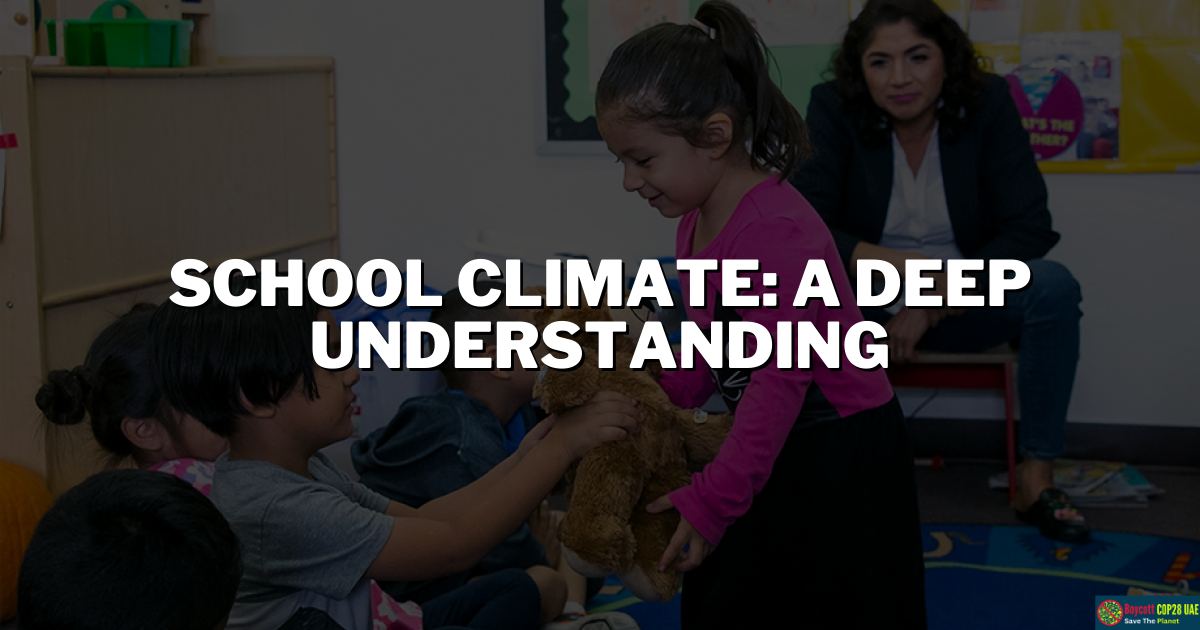What is the School Climate? is a term used to describe a school’s atmosphere and overall experience for both students and staff.
We all have memories from our school days that stand out ,whether they were positive or negative experiences. These experiences can shape our learning and development. We remember feeling either safe or unsafe, being with someone who cared about us or feeling very alone, enjoying learning or not being interested. These memories are a part of the school climate.
However, school climate is not just about individual experiences. It also involves a group process that emerges when people work together. A comprehensive assessment of school climate takes into account significant aspects of school life, including larger organizational patterns.
Studies have shown that a positive school climate is associated with academic achievement, effective risk-prevention efforts, and positive youth development. So, creating a positive school climate is crucial for promoting learning and development among students.
What is The School Climate?
The term ” What is the school climate” refers to how the school feels and what it’s like to be there. This includes things like how students, parents, and teachers experience school life and the school’s values and goals. It also has how people interact with each other, how teaching and learning happen, and how the school is organized.
A school’s positive and sustainable climate helps young people grow and learn the skills they need to be successful and happy in society. A good school climate includes the following:
- Rules and expectations that make people feel safe and supported socially, emotionally, and physically
- People who are involved and treat each other with respect
- Students, families, and educators who work together to create a shared vision for the school
- Teachers who model and encourage a love of learning
- Everyone is doing their work to keep the school running smoothly and take care of the environment
School Climate Dimensions
Schools can be very different from one another. Some schools feel like a warm, welcoming and supportive place to learn, while others feel like an unfriendly and unwelcoming place. The atmosphere and attitudes that a school creates are called the “school climate.” School climate comprises many aspects that can be grouped into three main areas: physical, social, and academic.
The physical aspect refers to things like how the school and classrooms look, the size of the school and the number of students per teacher, how classrooms are organized, the resources available, and whether the school is a safe and comfortable place to be.
The social aspect looks at relationships between students, teachers, and staff, how fairly and equally students are treated, the level of competition and comparison among students, and how much input students, teachers, and staff have in making decisions at the school.
The academic aspect focuses on the quality of instruction, teacher expectations for student achievement, and how well student progress is monitored and communicated to students and parents.
School Climate And Student Behavior
Research has found that how students feel about their school can affect how well they do and behave. Students who think positively about their school are more likely to be motivated and do better academically. On the other hand, if they have negative feelings about school, they may be more likely to have behavior problems, like fighting, lying, and cheating, or emotional issues, like feeling anxious, sad, or lonely.
It’s important to note that a positive school environment can also help students at risk for these problems. For example, if a student has a difficult temperament, is very self-critical, or doesn’t believe in their ability to succeed, a positive school environment can help offset these negative factors and improve their chances of doing well. So, having a positive school environment is vital for all students, but especially for those who may be struggling.
School Climate And Student Outcomes
What is the School climate refers to how students feel about their school. When students feel connected to their school and have a sense of belonging, it can protect them from negative outcomes. Research shows that improving school climate by increasing students’ sense of connectedness can decrease behavioral and emotional problems.
Understanding the processes underlying the relationship between school climate and student outcomes is essential to develop effective interventions. One mechanism that may explain this relationship is school connectedness, when students feel close to others at school. By focusing on improving students’ sense of connectedness, we can decrease the probability of negative outcomes.






